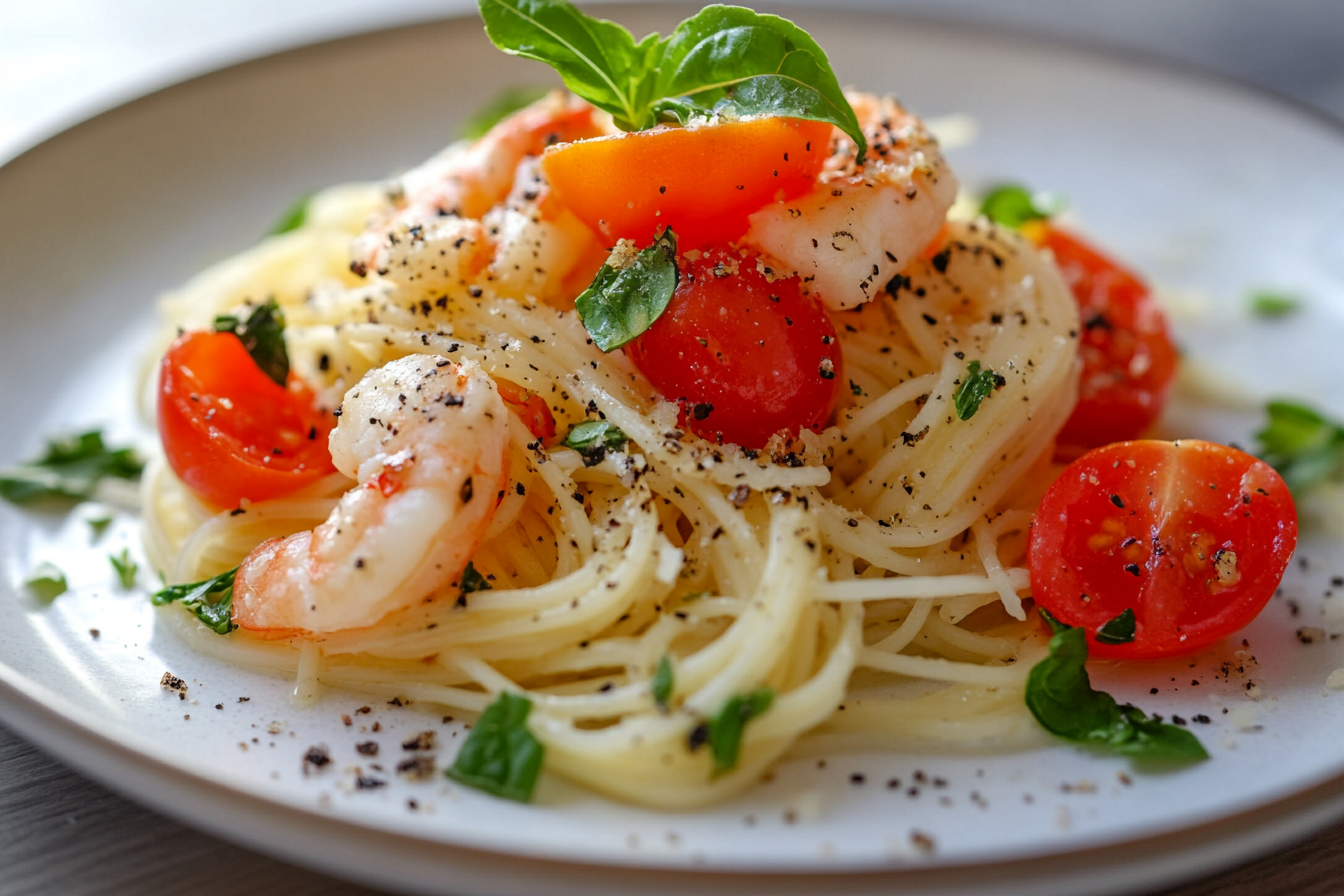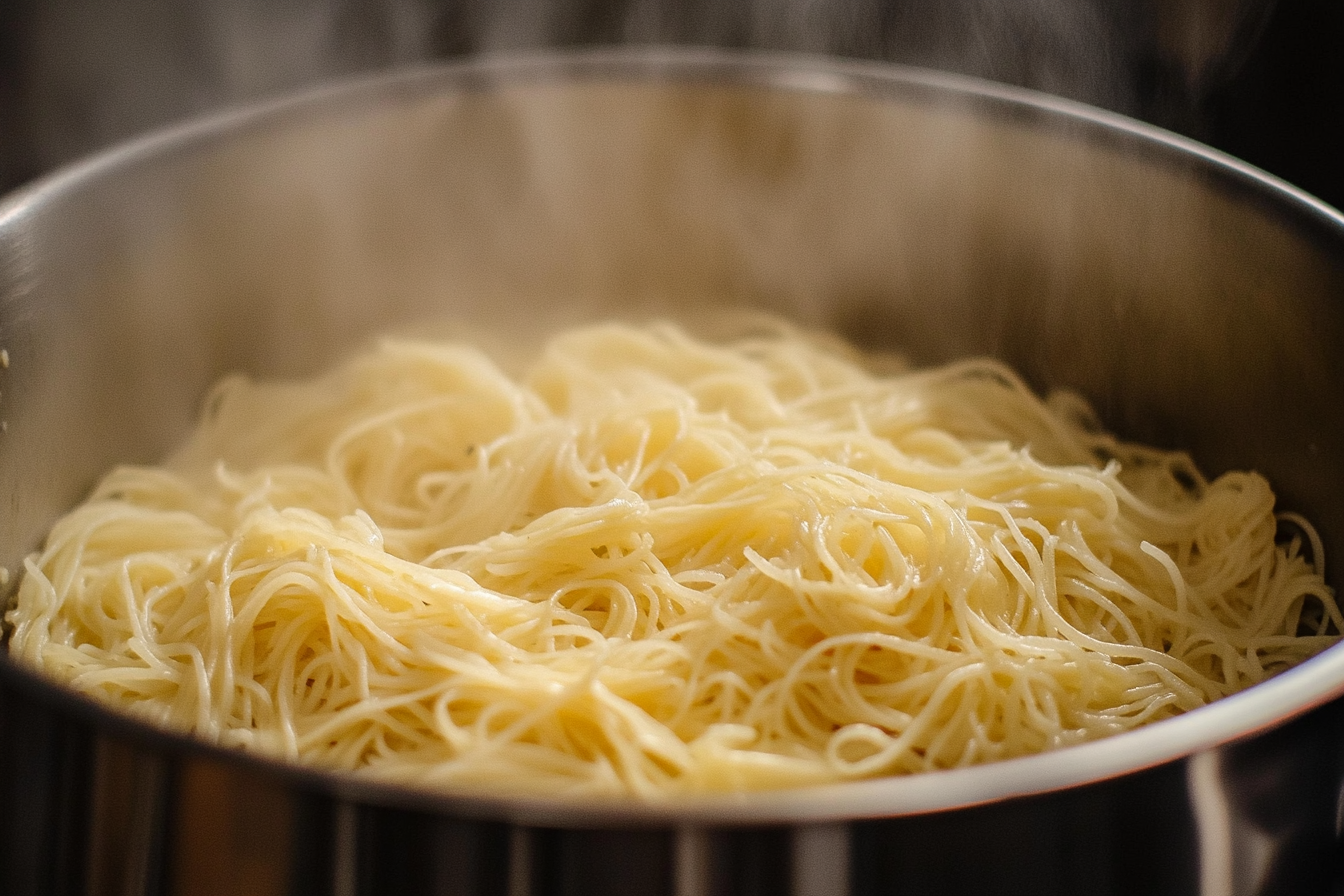Choosing the right pasta is crucial, especially with delicate varieties like capellini and vermicelli. While they appear similar, their differences in texture, thickness, and use can impact your dish. This guide breaks down those differences, ideal pairings, and substitution tips to help you create the perfect meal.
What Are Capellini and Vermicelli?
Both capellini and vermicelli are long, thin pasta types, but their subtle differences make them better suited for different types of dishes. Let’s explore what sets them apart:
- Capellini: Also known as angel hair pasta, capellini is an extremely fine pasta with very delicate strands. It cooks quickly and is best paired with lighter sauces, allowing the pasta’s texture to shine. Capellini is ideal for meals where the sauce or ingredients won’t overpower its delicate structure.
- Vermicelli: While also thin, vermicelli is slightly thicker than capellini. It is more robust and can handle heavier sauces and heartier ingredients. This makes thin noodles a versatile option that works well in soups, stir-fries, and even baked dishes. In Italian cuisine, vermicelli refers to a fine, long pasta, while Asian cuisine often uses thin noodles made from rice or other starches.
For a more detailed breakdown of the uses and pairings for capellini, check out the comprehensive capellini guide, which delves into various culinary applications.
Historical Background: The Origins of Capellini and Vermicelli
Understanding the history of these pastas provides a richer appreciation for how they are used today.
The Italian Origins of Capellini
Capellini originated in Italy, named “little hairs” for its thin strands. Monks and nuns made it by hand, boiling the dough in broths or tossing it with simple sauces. Its quick cooking time and pairing with delicate Italian flavors made it popular over time.
In northern Italy, chefs often use thin pasta in dishes featuring seasonal vegetables, seafood, and herbs. This pasta’s role in Italian culinary history highlights its delicate nature, making it a staple in light, elegant meals where subtlety is key.
The Broader Reach of Vermicelli
Vermicelli also has Italian roots, but its use has spread far beyond Italy, with variations of vermicelli appearing in a number of different cuisines. In Italian, the name “vermicelli” means “little worms,” which refers to the long, thin shape of the pasta. In Italian cuisine, thin noodles is traditionally paired with heavier sauces or used in baked pasta dishes.
Vermicelli’s versatility extends to Asian cuisine, where it refers to thin rice or mung bean noodles. Chefs use it in dishes like Vietnamese bun cha or Thai pad woon sen. In Asia, people serve vermicelli in soups, stir-fries, or cold salads, allowing it to absorb the flavors of the ingredients.
Texture and Thickness: Key Differences
One of the most important differences between capellini and vermicelli is their texture and thickness, which greatly influences their cooking time and the types of dishes they complement.
Capellini’s Fine, Delicate Texture
Capellini is known for its ultra-fine strands and soft texture. It’s a pasta that cooks quickly usually in just 2-3 minutes and has a light, airy quality that allows it to blend seamlessly into dishes. Its thinness makes it ideal for dishes with simple, light sauces, as heavier sauces can overwhelm the pasta. Because of its delicate nature, capellini must be cooked with care to avoid becoming too soft or mushy.
Vermicelli’s Versatile, Sturdy Structure
Although people still consider vermicelli a thin pasta, it has a slightly thicker and firmer texture than capellini. This sturdier structure makes it more versatile in terms of what it can pair with. thin noodles can hold its shape when paired with heavier, more robust sauces, making it ideal for use in dishes with rich meat sauces or thick vegetable mixtures. It can also be used in baked dishes, soups, and stir-fries without losing its integrity.
Vermicelli’s firmer texture absorbs bold flavors, which is why chefs commonly use it in both Italian and Asian cuisines, where complex, flavorful sauces are the norm. If you want to explore more about how angel hair pasta compares to capellini, check out this in-depth comparison article on capellini and angel hair.
Global Culinary Applications: How Capellini and Vermicelli Are Used Around the World
Capellini in Italian Cuisine
In Italy, chefs often feature capellini in dishes that highlight its delicate texture. They typically pair it with light, fresh ingredients that won’t overpower the pasta. Popular Italian dishes that highlight thin pasta include:
- Capellini aglio e olio: A simple yet flavorful dish made with garlic, olive oil, and sometimes red pepper flakes.
- Capellini al limone: A light pasta dish featuring lemon juice and zest, combined with olive oil and fresh herbs, making it a refreshing choice for warm-weather meals.
- Capellini with seafood: This pasta pairs beautifully with seafood, such as shrimp, scallops, or clams. The fine strands absorb the delicate flavors of the seafood and any accompanying sauce without overwhelming the dish.
Because of its quick cooking time, capellini is also a go-to choice for busy weeknight meals where simplicity and speed are essential.
Vermicelli in Asian Cuisine
thin noodles holds a prominent place in many Asian dishes, where chefs often make it from rice or mung beans rather than wheat. In Asian cuisine, people typically use vermicelli in:
- Vietnamese bun cha: A popular dish featuring grilled pork served over a bed of vermicelli noodles with fresh herbs and a dipping sauce made from fish sauce, lime juice, and sugar.
- Chinese vermicelli stir-fries: Vermicelli noodles are stir-fried with vegetables, soy sauce, and sometimes meat or tofu. The noodles absorb the flavors of the sauce while maintaining a firm, chewy texture.
- Thai vermicelli salads: Cold thin noodles salads are popular in Thailand, often featuring a mix of fresh vegetables, herbs, and a tangy dressing made from lime juice, fish sauce, and chilies.
These dishes highlight vermicelli’s ability to absorb rich, complex flavors, making it a staple in many Asian kitchens. Its versatility and sturdiness allow chefs to use it in both hot and cold dishes, from soups to salads.
Nutritional Value and Health Benefits of Capellini and Vermicelli
vermicelli and Capellini are low in fat and rich in carbs, but their thickness and ingredients cause slight nutritional differences.
Capellini: Light and Low-Calorie
thin pasta is a great option for those looking for a low-calorie, low-fat pasta. A typical serving of thin pasta (about 2 oz) contains around 200 calories, with minimal fat and around 7 grams of protein. It is also a good source of complex carbohydrates, which provide long-lasting energy without causing spikes in blood sugar levels.
Because capellini pairs best with light sauces and ingredients, chefs often use it in dishes that are lower in calories and fat compared to richer pasta dishes made with heavier sauces like Alfredo or Bolognese.
Vermicelli: A Versatile, Filling Option
Vermicelli, being slightly thicker, tends to be slightly higher in calories per serving compared to capellini. A typical serving contains around 220-240 calories, with similar amounts of protein and carbohydrates. However, vermicelli’s thicker structure makes it more filling, meaning it may leave you feeling fuller for longer.
Vermicelli made from rice or mung beans, commonly found in Asian dishes, can also be a great gluten-free option for those with dietary restrictions.
Comparing Nutritional Profiles
- Calories: Vermicelli typically has a slightly higher calorie count than thin pasta due to its thicker texture.
- Protein: Both pastas provide a similar amount of protein per serving, making them a good source of energy for vegetarians when paired with other protein-rich ingredients like beans or tofu.
- Carbohydrates: Both are rich in complex carbohydrates, which provide sustained energy throughout the day.
Cooking Techniques: Perfecting Capellini and Vermicelli
Mastering the proper cooking techniques for thin pasta and vermicelli is essential for achieving the best texture and flavor in your dishes.
Cooking Capellini: Light and Quick
Because of its fine texture, capellini cooks very quickly usually in 2-3 minutes. Follow these steps for perfect results:
- Use a large pot of salted water: Make sure the water is at a rolling boil before adding the capellini.
- Stir gently: As soon as you add the pasta, stir gently to prevent the delicate strands from sticking together.
- Watch the clock: Capellini can overcook very quickly, so be sure to drain it after just 2-3 minutes.
- Toss with sauce immediately: To prevent clumping, toss the drained pasta with a bit of olive oil or sauce as soon as it’s done cooking.
Chefs use thin pasta best when combined immediately with sauce, allowing it to absorb flavors while keeping its delicate texture.
Cooking Vermicelli: Versatile and Firm
Vermicelli takes slightly longer to cook than capellini, typically 3-5 minutes depending on the thickness and the specific dish. Here are some tips for cooking vermicelli:
- Use plenty of water: Like capellini, vermicelli should be cooked in a large pot of salted water to ensure even cooking.
- Cook until al dente: Vermicelli should be cooked until it’s firm but tender. This typically takes around 4 minutes, but it’s important to check the pasta for doneness by tasting it.
- Drain well: If using vermicelli in a stir-fry or salad, rinse the pasta under cold water after draining to stop the cooking process and prevent sticking.
Vermicelli’s firmer structure makes it ideal for soups and stir-fries, where the noodles need to hold up under heat and absorb the surrounding flavors.
While it is possible to substitute capellini for vermicelli and vice versa in some recipes, there are a few key factors to consider.
- Capellini cooks: faster than vermicelli, so adjust the cooking time if swapping them. Overcooking capellini will result in a mushy texture that can ruin a dish.
- Sauce compatibility: Capellini works best with lighter sauces, while vermicelli can handle heavier, more robust sauces. Vermicelli is a better choice for dishes with thick meat or heavy cream-based sauces.
- Texture: Because of its fine texture, thin pasta often fails to hold up well in soups or baked dishes that require a firmer pasta.
The decision to substitute one for the other depends on the recipe and the type of sauce or ingredients.
Frequently Asked Questions (FAQs)
1. Can you substitute capellini for vermicelli in any recipe?
Yes, but consider the type of sauce and the cooking time. thin pasta pairs best with light sauces, while vermicelli suits heartier, more robust dishes.
2. Is vermicelli thicker than capellini?
Yes, thin noodles is slightly thicker than capellini, which makes it a better choice for dishes that require a sturdier pasta.
3. What’s the best sauce to pair with capellini?
Light olive oil or simple tomato-based sauces work best with thin pasta due to its delicate texture. Seafood-based sauces also complement thin pasta well.
4. Are capellini and vermicelli gluten-free?
Traditional thin pasta and vermicelli are made from wheat and are not free of gluten. However, free of gluten versions made from rice or other grains are widely available.
Conclusion
Choosing between capellini and vermicelli can greatly impact your dish, whether it’s a light seafood or heartier pasta meal. Understanding their differences in texture, thickness, and sauce compatibility will help you make the best choice.
For more pasta inspiration, explore the variety of recipes and guides available on Eira Recipes, where you’ll find tips, tricks, and culinary ideas for all your cooking needs.



